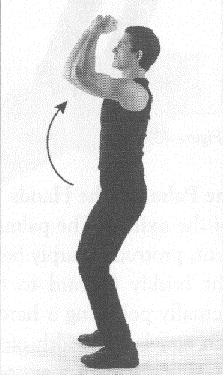
Fig. 404
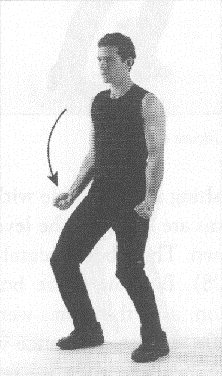
Fig. 405
1. Fists Above the Shoulders
The hands are held by the sides, clasped into fists, the palms facing
up. They are raised then to a point above the head by bending the elbows
so the forearms are at a ninety-degree angle with the upper arms. The driving
force of this movement is equally divided between the muscles of the arms
and the contraction of the muscles of the abdomen. As the fists are raised
and the muscles of the front of the body are tensed, the body leans slightly
backward by bending the knees (fig. 404). The arms, with hands fisted,
are brought down to the sides of the thighs by straightening the elbows
a bit; as the arms move down, the body leans forward, contracting the muscles
of the back and the diaphragm (fig. 405).

Fig. 404 |

Fig. 405 |
2. Using a Cutting Tool in Each Hand
The hands are made into fists, with the palms facing each other at the
level of the waist (fig. 406). From there, they move in a downward strike
to the level of the groin, a foot and a half away from it, always keeping
the width of the body as the distance between the fists (fig. 407). Once
the fists strike, they are retrieved to the position where they started
by the edge of the rib cage.
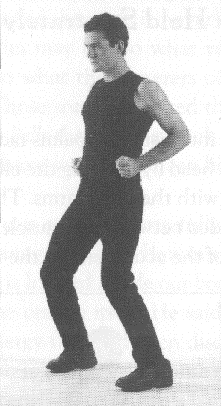
Fig. 406 |
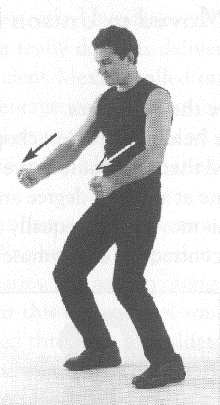
Fig. 407 |
3. Polishing a High Table with the Palms of the Hands
The arms are raised to the level of the axillae. The palms of the hands
face down. The elbows, acutely bent, protrude sharply behind the back (fig.
408). Both arms are brought briskly, forward to the maximum extension,
as if the palms were actually polishing a hard surface. The hands are kept
at a distance which equals the width of the body (fig. 409). From there,
they are retrieved with equal force to the position where the movement
begin (fig. 408).
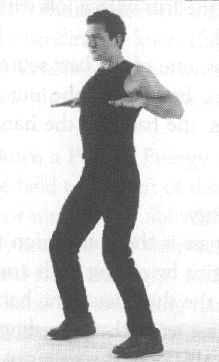
Fig. 408 |
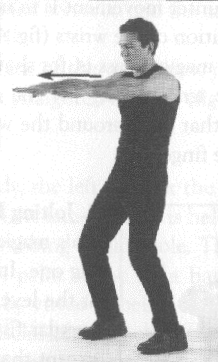
Fig. 409 |
4. Tapping Energy with Both Hands
Both 'arms are raised to the front, at the level of the shoulders. The hands are held in angular fists, meaning that the position of the fingers slants down heavily as they are held against the palm of the hands. The thumbs are held on top of the outer edge of the index fingers (fig. 410). The palms of the hands face each other. A sharp jolt of the wrists makes the fists go down slightly, but with great force. The level of the wrists never changes; in other words, only the hand pivots down on the wrists.
The counter movement is to raise the fists with a jolt without changing the position of the wrists (fig. 411).
This magical pass is, for shamans, one of the best sources for exercising
the tendon energy of the arms, because of the number of energy points
that exist around the wrists, the backs of the hands, the palms, and the
fingers.
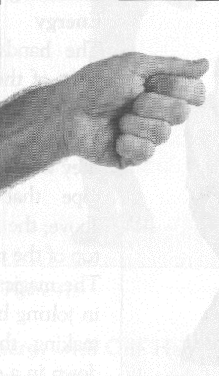
Fig. 410 |
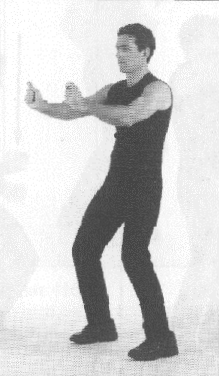
Fig. 411 |
5. Jolting Energy
This magical pass is the companion to the preceding one. It begins by raising both arms to the front at the level of the shoulders. The hands are held in angular fists, just as in the preceding magical pass, except that in this one, the palms of the hands are turned to face downward. The fists are moved in toward the body by a jolt of the wrists. Its counterbalancing movement is another jolt of the wrists that sends the fists outward so that the thumbs make a straight line with the rest of the forearm (fig. 412). In order to execute this magical pass, it is required that the muscles of the abdomen are intensely used. It is the action of those muscles which actually directs the jolting of the wrists.
6. Pulling a Rope of Energy
The hands are held in front of the body, at the line that separates the left and the right bodies, as if they were holding a thick rope that hangs from above; the left hand is on top of the right (fig. 413). The magical pass consists in jolting both wrists and making the hands jerk down in a short, powerful movement. As this movement is executed, the muscles of the abdomen contract, and the arms drop down slightly by bending the knees (fig. 414).
Its counterbalancing movement is a jerk of the wrists that jolts the
hands upward as the knees and the trunk straighten up a bit (fig. 413).
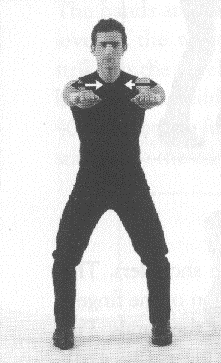
Fig. 412 |
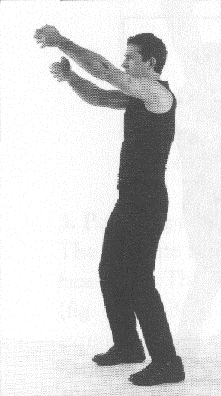
Fig. 413 |
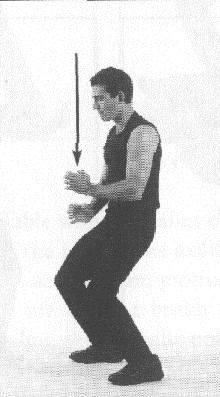
Fig. 414 |
7. Pushing Down a Pole of Energy
The hands are held to the left of the body, the left hand at the level
of the ear, eight or nine inches above the right hand, which is held at
the shoulder. They are held as if they were grabbing a thick pole. The
palm of the left hand faces the right; and the palm of the right hand faces
left. The left hand is the leading hand, by virtue of being on top, and
guides the movement (fig. 415). The muscles of the back by the area of
the adrenals and the muscles of the abdomen contract, and a powerful push
sends both arms downward to the side of the right thigh and the waist,
as if they were indeed holding on to a pole (fig. 416). The hands change,
position there; the right hand moves to a place by the right ear and becomes
the leading hand, and the left moves below, by the shoulder, as if the
hands were changing poles. The same movements are repeated.
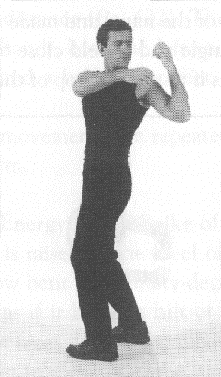
Fig. 415 |
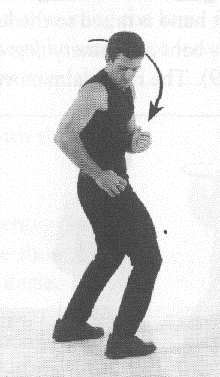
Fig. 416 |
8. Cutting Energy with One Hand at a Time
The fists are raised on the sides until they touch the edge of the rib
cage; the palms of the fists face each other (fig. 417). The left arm moves
down in a diagonal line to a point two feet away from the thigh (fig, 418);
then it is retrieved (fig. 417). The right arm immediately performs the
same movements.
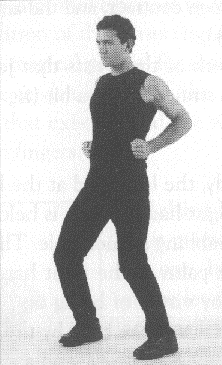
Fig. 417 |
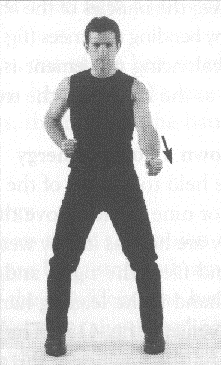
Fig. 418 |
9. Using a Plane of Energy
The left hand is raised to the level of the navel and made into a fist; the elbow is bent at a ninety-degree angle and is held close to the rib cage (fig. 419). The right palm moves as if to slam on top of the left fist. The right hand stops an inch away from the left (fig. 420). Then it moves four or five inches in front of the fist, in a sharp, cutting movement, as if cutting with the edge of the hand (fig. 421). The left arm is retrieved all the way back by making the elbow protrude backward as far as it can, while the right hand is also retrieved, following the left hand and keeping the same distance (fig. 422). Then, maintaining the same distance between the hands, both the left and the right arm shoot forward to a point a foot and a half or two feet away from the waist.
The same movements are repeated with the fist of the right arm.
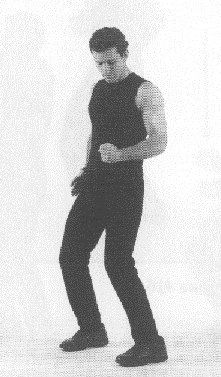
Fig. 419 |
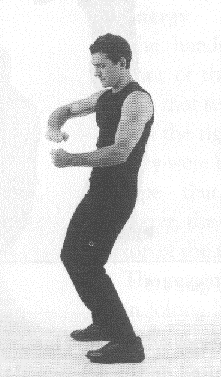
Fig. 420 |
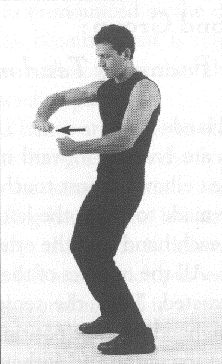
Fig. 421 |
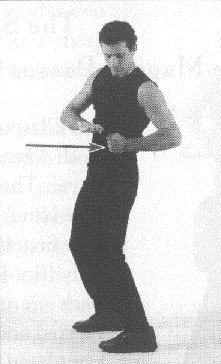
Fig. 422 |
10. Striking Energy with a Spike of Energy
The left arm is raised to the level of the shoulders with the elbow bent at a ninety-degree angle. The hand is held as if it had the hilt of a dagger in its grip; the palm faces down. The elbow strikes backward in an arc to a point at the height of the left shoulder, at a forty-five-degree angle behind it (fig. 423). Then the arm returns with a strike along the same arc to its initial position.
The same movement is repeated with the other arm.
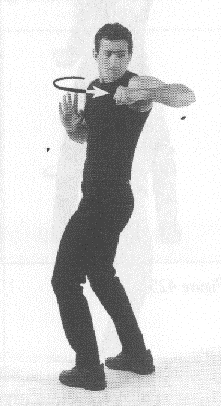
Fig. 423 |